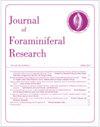最近墨西哥湾飓风的有孔虫特征
IF 0.9
4区 地球科学
Q4 PALEONTOLOGY
引用次数: 7
摘要
本文章由计算机程序翻译,如有差异,请以英文原文为准。
The foraminiferal signature of recent Gulf of Mexico hurricanes
Down-core activities of â·Be ²³â´Th and ²¹â°Pb as well as X-radiography have indicated the existence of sediments deposited by hurricanes Ivan (2004) Katrina (2005) and Rita (2005) on the continental margin west of the Mississippi Delta between Southwest Pass and the Mississippi Canyon. These radionuclides have fairly short half-lives on the order of days to decades however and their utility for the identification of hurricane events decreases with progressively older deposits. Foraminifera which can be preserved for geologically significant amounts of time may serve as another proxy for the detection of hurricane event beds. Here I investigate foraminiferal assemblages contained within recent known hurricane units to determine whether they differ significantly from those of non-hurricane units and a unit deposited by a river flood event and whether these differences might give insight into where the hurricane-deposited sediment originated. Cores were collected along the same transect during three different cruises in: 2004 2005 and 2007; the timing of collection reflected periods of hurricane and non-hurricane influenced deposition. The transect runs southwest from Southwest Pass (~30 m water depth) to the head of the Mississippi Canyon (~170 m depth). Surface samples of a unit deposited by the 2011 Mississippi River flood event were also collected to allow comparison with hurricane units. Average relative abundances of foraminifera were analyzed for trends and ANOVA and discriminant analysis were utilized to determine whether the foraminiferal assemblages of hurricane and non-hurricane units were statistically discrete. Hurricane unit foraminifera very close to the mouth of Southwest Pass (9 km; ~30 m water depth) were more abundant per unit volume of sediment than pre-hurricane foraminifera at this location. Hurricane units further out on the shelf (> 80 m water depth) tended to contain less foraminifera per unit volume than did the non-hurricane units. Hurricane units also contained more textulariids and miliolids than the non-hurricane units and sometimes contained rare marsh taxa. ANOVA results show that the abundances of 13 of the 32 most abundant taxa were statistically different between units when comparing all four unit types (hurricane pre- and post-hurricane flood and bioturbated). Ten of these species were statistically different between hurricane and non-hurricane units; relative abundance of coastal taxa increased in the hurricane units. Discriminant analysis indicates that all four unit types are generally discrete. The species that contributed most to the discrimination of unit types were generally rare and some were helpful in the determination of the origin of the hurricane-transported sediment. In contrast the species that were significant in the ANOVA were among the most abundant. Thus both abundant and rare species are useful for identifying hurricane deposited sediment. A portion of hurricane unit sediments was likely locally resuspended and redeposited (indicated by high relative abundances of those taxa which were abundant in the pre- and post- hurricane units). There is also evidence of seaward transport of sediment; some species that occur in the pre- and post-hurricane units only at the shallow end of the transect also occurred in hurricane units at the deeper end of the transect. In addition hurricane units contained some rare marsh and upper slope taxa which were absent from the pre- and post-hurricane units indicating some portion of the sediment in the hurricane units is derived from these environments. In summary foraminifera can provide information on the provenance of hurricane-deposited sediment soon after deposition but bioturbation can destroy this signal rapidly.
求助全文
通过发布文献求助,成功后即可免费获取论文全文。
去求助
来源期刊
CiteScore
2.10
自引率
9.10%
发文量
32
审稿时长
>12 weeks
期刊介绍:
JFR publishes original papers of international interest dealing with the Foraminifera and allied groups of organisms. Review articles are encouraged.

 求助内容:
求助内容: 应助结果提醒方式:
应助结果提醒方式:


